ISSN ONLINE(2319-8753)PRINT(2347-6710)
ISSN ONLINE(2319-8753)PRINT(2347-6710)
Anwar S. Siddiqui1 and Manisha Rani2
|
| Related article at Pubmed, Scholar Google |
Visit for more related articles at International Journal of Innovative Research in Science, Engineering and Technology
For the efficient transmission of power from power plants to consumer loads, the power losses are reduced in modern power system. In order to reduce such losses, a recently evolved FACTS technology is used. In this paper, Thyristor Controlled Series Capacitor (TCSC) is selected to enhance the loadability in the transmission line. To improve the maximum power transfer capability by this device an improved gravitational search algorithm (IGSA) is suggested. Velocity of each agent is improved by this proposed algorithm. If the velocity is high then agents move to a better solution or else the optimum solution might not be achieved. Through the mass determination of each agent, all the solutions are contributing to the optimum solution. Here the maximum power loss of the system is considered as a fitness function. The proposed algorithm is validated on IEEE-57 test system using MATLAB platform. Thus with the help of IGSA the maximum power transfer capability is achieved and that with the economic cost of the device.
Keywords |
| Economic cost, FACTS, Fitness function, IGSA, TCSC |
INTRODUCTION |
| Modern power system consists of numerous generation, transmission lines, various loads and transformers. The power system becomes more and more complicated with the increasing power flow and insecure with the natural power flows and higher losses. The secure power system can be achieved by implementing newly introduced FACTS technology. FACTS devices relieve the congestion in the power lines thus making it to operate near to its thermal limits. FACTS devices control the various parameters such as reactive power, phase angle, bus voltages and series impedance thus controlling the power flow. FACTS devices such as TCPAS, TCSC, SVC, IPFC, SSSC etc are used to enhance the maximum power flow in the lines. Moreover, these devices improve the dynamic and transient stability limit of the network. |
| In this paper, TCSC is used to enhance the loadability of the power system using IGSA (improved gravitational search algorithm). IGSA is superior to traditional GSA (gravitational search algorithm). IGSA converges faster and reduces computational complexity as compared to GSA. |
| The following section 2 describes literature review. Section 3 is about the modelling of TCSC (thyristor controlled series capacitor). Section 4 gives results and discussion followed by conclusion in section 5. |
LITERATURE REVIEW |
| K Vijayakumar et al. have offered an alternate algorithm, using genetic algorithm to work out the optimal power flow problem integrating stretchy AC transmission system devices (FACTS) in a multi machine power system [1]. Their proposed technique specified the site, their group and rating of FACTS appliances was optimized at the similar time. TCSC and the UPFC were considered among the dissimilar facts tools. For finding out the most constructive option and distribution of FACTS tools, such that the overall system cost which holds of generation cost and the investment cost of FACTS tools were reduced, their proposed algorithm was used. |
| Bhattacharya et al. [2] has offered a GSA for functioning out the multi-objective optimal power flow problem. GSA was sustained by the Newton's law of gravity and mass interactions. By means of law of gravity and motion of Newton, their proposed algorithm agents were a collection of masses that function together with each other. By their proposed plan, the multi-objective OPF problems were worked out. A normal 26-bus and IEEE 118-bus plans with three different individual objectives, that is fuel cost minimization, active power loss minimization and voltage deviation minimization, were calculated. In multi-objective problem formulation fuel cost and loss; fuel cost and voltage deviation; fuel cost, loss and voltage deviation were reduced at the same time. Evolutionary programming and genetic algorithm, their proposed technique results were assessed with a different integer particle swarm optimization. The convergence speed and global search capacity were demonstrated by simulation effects that had been confirmed by them. |
| M Basu have offered a multi-objective optimal power flow with FACTS appliances to optimize cost of production, mission and dynamic power communication power systems [3]. With his presented system the optimal power flow problem was produced as a multi-objective optimization problem. FACTS appliances contain TCSC and TCPS. His proposed strategy has been monitored and tested on the modified IEEE 30-bus and 57-bus test systems. The effects accomplished from his proposed strategy have been matched up with those achieved from non dominated arranging GA-II, strength pareto evolutionary algorithm and pareto differential evolution. |
| H. Farahmanda et al. have suggested an enhanced evaluation of Available Transfer Capability (ATC) [4]. Initially, this was attained by Comparing a classic application of the Particle Swarm Optimization (PSO) method with conventional GA methods is completed in order to reach Hybrid Mutation Particle Swarm Optimization (HMPSO) method. Consequently, a multi-objective optimization problem concerning optimal installation and capacity allocation of FACTS tools was presented and confirmed. For working out non-linear power system problems the Modern heuristic methods such as PSO have been launched to be suitable strategies. The result of this research more reveals that with enhanced utilization of FACTS tools, it was feasible to develop transmission capabilities. The transmission systems operators (TSOs) were offered with more options when procuring transmission services by the current deregulated environment. |
| Suppakarn Chansareewittaya et al. [5] have offered evolutionary programming (EP), split and non split search space managing techniques for optimally sitting and settings of FACTS tools to improve the power transfer capability among generators and load buses. Regarded FACTS were TCSC and SVC which were independently assessed to maximize the power transfer capability in addition to minimizing power losses. The presentation of the suggested one is experimented on IEEE 118-bus system and the practical Electricity Generating Authority of Thailand (EGAT) 58-bus system. From simulations, they demonstrated that EP with optimal maximum number of FACTS and the suggested split search space managing technique gave higher power transfer capacity and less maximum number of FACTS controllers than those from non-split technique. |
| In the power network during standard and contingency cases, G Madhusudhana Rao et al. [6] have suggested real code GA for optimizing the location and controlling parameters of TCSC and SVC for accomplishing maximum available transfer capability (ATC). Using Continuous Power Flow (CPF) technique, ATC was calculated regarding both line thermal limit with bus voltage limits. The presentation of the suggested real-code GA had been experimented on IEEE 24-bus dependability test system. They demonstrated that the installing SVC through simulations assisted in enhancing voltage profile plus ATC improvement, where as TCSC enhanced ATC in both thermal dominant case and voltage dominant case. Finally, they winded up that TCSC was more efficient than SVC in enhancing ATC under both standard and possibility conditions. |
| Determining the optimal power transfer capability of power system is a complex problem. In recent research works various algorithms and control techniques have been discussed to work out the optimal power flow problem. Algorithms such as simulated annealing, tabu search, genetic algorithm, ant colony algorithm, particle swarm algorithm, evolutionary algorithm etc are used. But all these algorithms are suited for a particular problem. GSA is the newly introduced algorithm to determine the optimal power in the power system. Unfortunately, GSA is not meant for high and low dimensional search space. Hence an improved version of GSA is needed to accomplish the power system loadability enhancement |
MATHEATICAL MODELLING OF TCSC |
| TCSC (thyristor controlled series capacitor) is a variable impedance type FACTS device which is connected in series with the transmission line to improve the power transfer capability also decreases the transmission losses and enhances transient stability. TCSC consists of capacitor connected in series with the transmission line and a thyristor-controlled inductor connected in parallel with the capacitor. Impedance of the transmission line can be varied using bi-directional valves. TCSC generates or absorbs reactive power by capacitor or reactor banks, which is required for compensation. It cannot exchange real power with the AC system. The single line diagram of TCSC is illustrated in Fig. 1. |
 |
| In the above figure, TCSC is connected between buses i and j. It is a series connected device which varies the line impedance as per requirement. It consists of: one capacitor C, one inductor L and two thyristor switched T1 and T2. |
| The equivalent circuit model of the illustrated TCSC is presented in Fig. 2. |
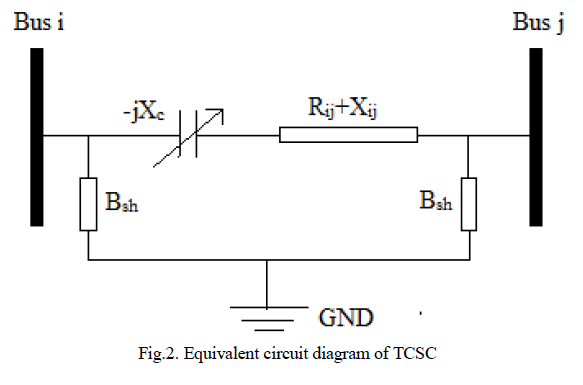 |
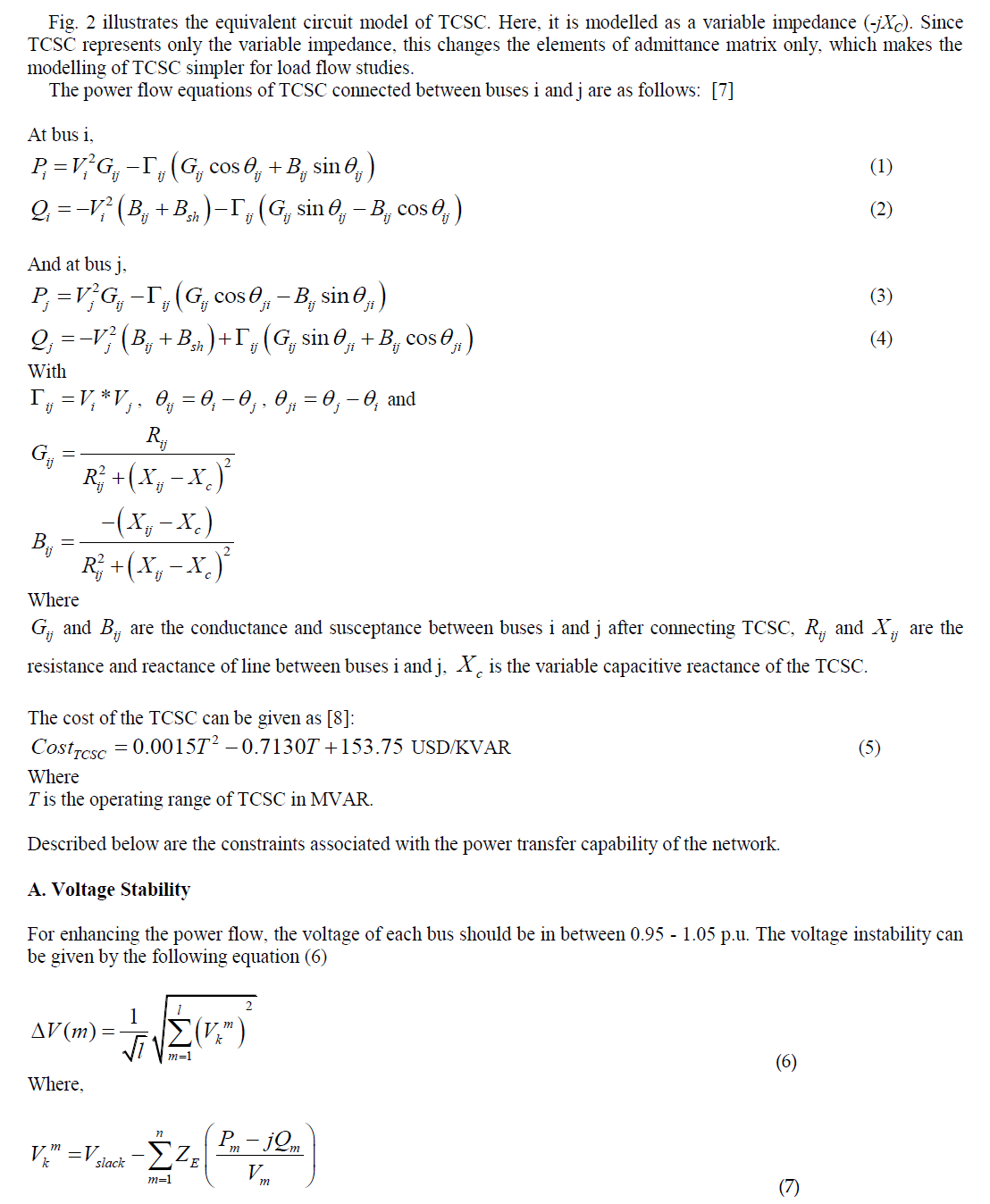 |
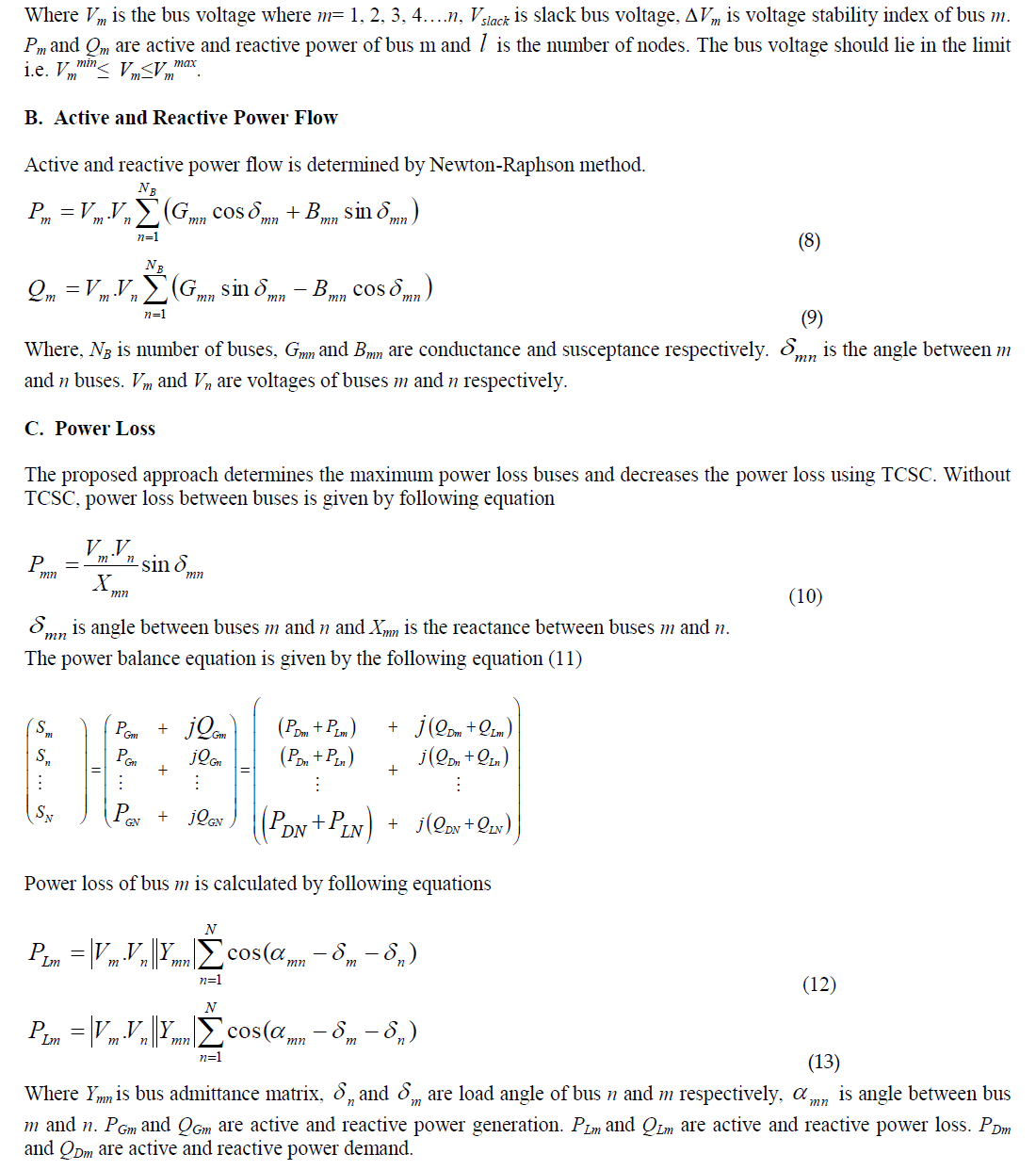 |
PROPOSED APPROACH |
| In this paper improved version of GSA (gravitational search algorithm) is proposed to solve the optimization problem. GSA is a recently evolved algorithm used to sole the global optimization problems. But it is not suitable for maximum power transfer capability of the network. This search algorithm solves the optimization problems with a high dimensional search space. Maximum power transfer capability is related to high and low dimensional problem. Here IGSA is used to enhance the loadability of the transmission line using TCSC device. In IGSA (improved gravitational search algorithm) velocity of mass is improved. Agents move to a good solution when the velocity is high or else optimum solution may not be attained. |
RESULTS AND DISCUSSIONS |
| From table I, showing the bus voltage profile of IEEE-57 bus system, it is clear that voltage profile is improved when TCSC is implemented between buses (2-3-4) and 8-9-10) using IGSA. These buses are the best fitness buses i.e. maximum power loss buses hence these buses are chosen for device implementation. Voltage of each bus should lie between (0.95-1.05 p.u.) for stable operation of the system. TCSC is installed at fitness buses 2-3-4 and 8-9-1. It is seen from the table that voltage at various buses is improved as compared to GSA approach. With GSA approach there is not a considerable improvement in voltage at each bus. It is illustrated from Fig. 3 that the voltage is improved when TCSC is implemented with IGSA approach than with GSA. Blue bar indicate the GSA approach and red bar indicate the IGSA approach. Red bars are shorter than the blue bars which show that voltage is improved more with IGSA than with GSA. |
| Table II gives the power flow comparison of IEEE-57 bus system. It is clear from the table that the power flow is increased when TCSC is implemented between 2-3-4 and 8-9-10. Both the real and reactive power is increased when TCSC is implemented. The increase in power flow occurs more at the branches where TCSC is fixed. But power flows in other branches are also affected. |
| Table III gives the power loss comparison and cost of TCSC device when it is connected at fitness buses 2-3-4 and 8-9- 10. Power loss is greatly decreased when TCSC is implemented between buses 2-3-4. It is seen from the table that at position 8-9-10, cost is minimum. The optimum location of TCSC in the system depends upon minimum cost of TCSC. Hence bus 8-9-10 can be the location for TCSC installation which gives minimum cost. |
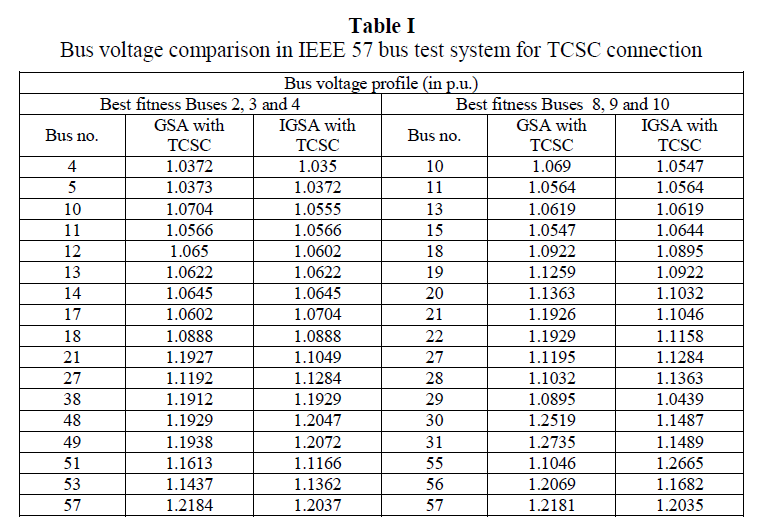 |
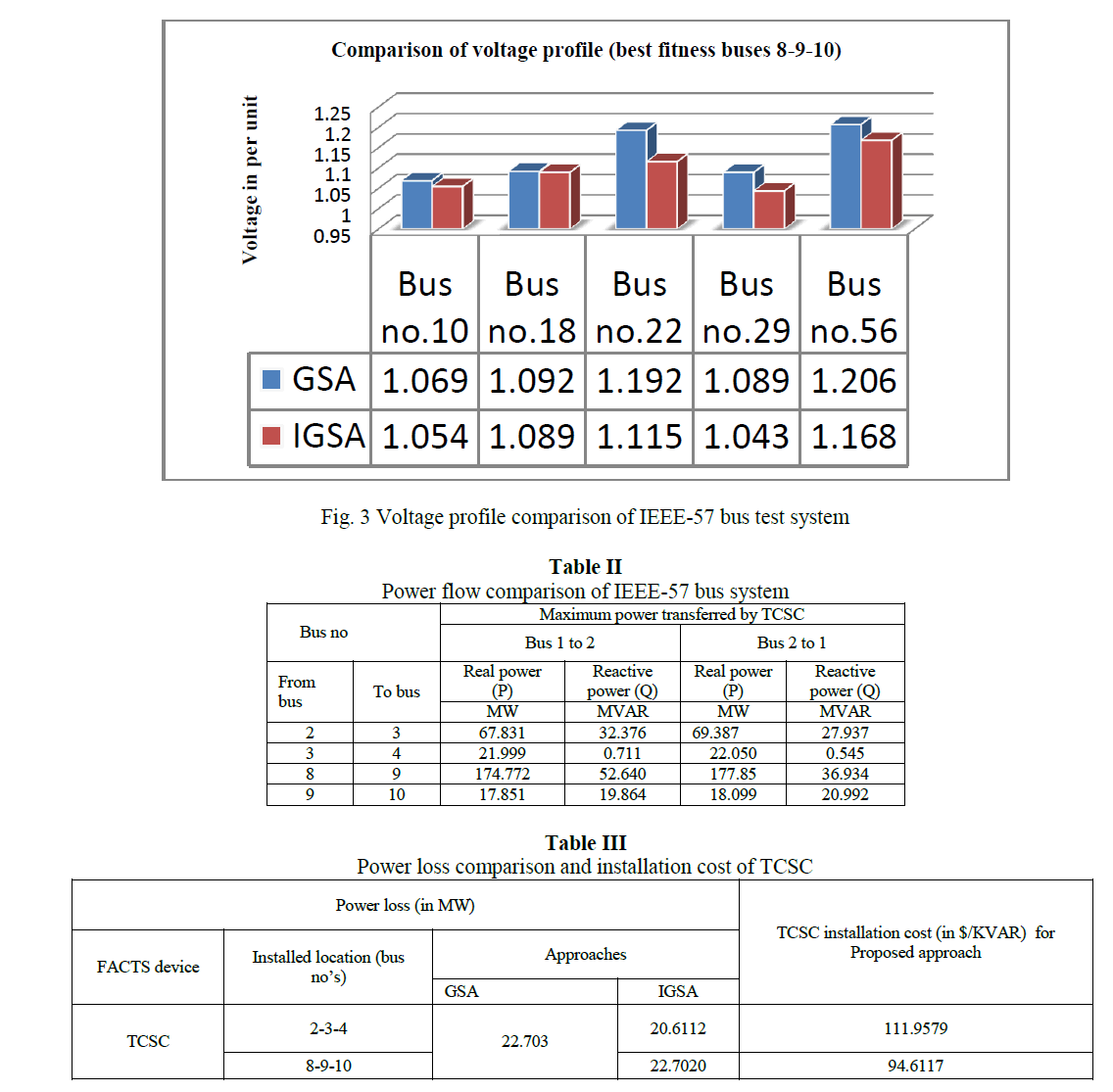 |
CONCLUSION |
| An improved gravitational search algorithm to enhance the maximum power transfer capability using TCSC is suggested in this paper. This is validated on IEEE-57 bus test system using IGSA. The computational complexity is reduced in the proposed approach by upgrading the velocity and position of agents. It is seen that TCSC improves the power flow by minimizing the power loss of the system using the proposed algorithm. Thus the maximum power transfer capacity of transmission line is improved using TCSC with IGSA approach. The results confirm that the IGSA is better than traditional GSA. |
References |
|